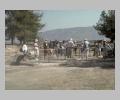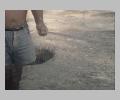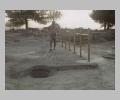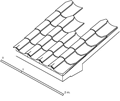
Wheel ruts across 5th Century B.C.E. altar. Isthmia.

Marble roof tile from the Temple of Poseidon. Isthmia.
| Summary: | One of the four major Panhellenic sanctuaries and site of the Isthmian Games, 2nd only to the Olympian Games in fame. |
| Type: | Sanctuary |
| Region: | Corinthia |
Periods:
Archaic
Classical
Hellenistic
Roman
Physical:
Located on the SE side of the Isthmus of Corinth, ca. 13 km E of ancient Corinth, the Sanctuary of Poseidon occupies a high point with a clear view to the Corinthian and Saronic Gulfs.
The main features of the sanctuary are the temple and altar of Poseidon and the stoas of the main temenos. Beyond the walls of the temenos are the stadium, theater, Roman Palaimonion shrine, and Roman baths. Associated with the sanctuary are cave shrines N of the theater and the Sacred Grove 400 m SW of the temenos.
Description:
Traditionally the sanctuary and games of honor of Poseidon were established by the Corinthian King Sisyphos or the Athenian Hero Theseus. The games were reportedly reorganized as a Panhellenic festival during the 49th Olympiad (582-578 B.C.) and held every 2nd spring thereafter. Control of the games was held by Corinth except for the period 146-44 B.C. when Corinth lay in ruins and Sikyon managed the games.
The Archaic temenos wall had a N and E propylon and enclosed a temple and altar. Outside the wall was a large 20 m deep well and a 16 lane stadium with a length of 192 m. In the Classical period the temenos was enlarged and stoas added. The original temple, destroyed by fire, was replaced by a temple that stood (with repairs in 390 B.C.) through the Roman period. The deep well outside the wall became a refuge pit and a new, shorter (181 m) stadium was constructed.
The Classical stadium was replaced in the Hellenistic period by a stadium located ca. 250 m SE of the temenos and at ca. 400 B.C. a theater was built ca. 30 m NE of the temenos. The theater was renovated twice in the Hellenistic period and twice in the Roman period. In the Roman period the temenos was again extended and new stoas built. The Palaimonion cult precinct was attached to the S side of the main temenos over the traditional burial place of Palaimon (associated with the Corinthian foundation legend for the sanctuary).
The sanctuary remained active during the Roman period, until it was sacked by the Goths in A.D. 395 At the beginning of the 6th century A.D. the structures in the sanctuary were pulled down for material to build the nearby fortress and Isthmia wall of Justinian.
Exploration:
In 1883 P. Monceaus of the French School investigated the site. It was re-studied and some test trenches dug in 1933 by R. Jenkins and A. Megaw. 1952-1961 excavations by University of Chicago directed by O. Broneer, who located the site of the sanctuary and excavated the temenos of Poseidon, the stadium, theater and shrine of Palaimon (including the earlier temple and stadium). 1967-1972 excavations by University of California directed by P. Clement, chiefly of the Isthmian fortifications and burials of the sixth and fifth centuries BC.
Sources Used:
Other Bibliography:
Main reports: Hesperia: 22 (1953) 182-95 (plans); 24 (1955) 110-41 (plans); 27 (1958) 1-37 (plans); 28 (1959) 298-343 (map & plans); 29 (1960) 168ff; 31 (1962) 1-25 (plans)



